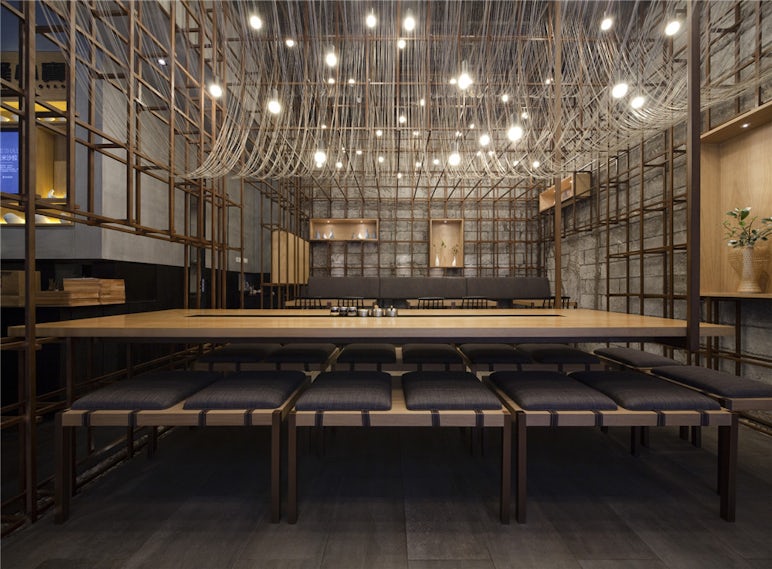Architects: Want to have your project featured? Showcase your work by uploading projects to Architizer and sign up for our inspirational newsletters.
With noodle consumption dating back over 4,000 years, this long, thin, wavy food has made its mark on many a region’s culinary history. The noodle is revered as a staple food in much of the world, emerging in a variety of forms and local dishes. Noodles come in such a diversity of shapes and flavors, often emerging out of local food traditions. The noodle bar has come to represent a space to share this culinary history and build on the legacy of the noodle.
The typology of the noodle bar usually centers around food prep, with a long seating area (the bar) adjacent to the kitchen. This emphasis on process gives visitors a more intimate experience of their food, understanding how it is made and how each specific restaurant has chosen to prepare their food. Rather than hiding the kitchen away, it is out in the open, engaging with visitors and showing the pride each chef takes in their work.

© STILE

© STILE

© STILE
Shyo Ryu Ken, Kyobashi by STILE, Osaka Prefecture, Japan
The Shyo Ryu Ken noodle bar in Kyobashi brings outside in, erecting miniature houses that resemble the pitched roofs of Japanese tenement houses, where guests can sit and watch the bustling bar and kitchen.

© Lukstudio

© Lukstudio

© Lukstudio
The Noodle Rack by Lukstudio, Changsha, China
The owner of The Noodle Rack wanted to bring the local Shao Yang style rice noodle to the rest of China. He commissioned Lukstudio to create a space that embodied the noodle making process. The façade is made from bamboo-cast concrete, and the interior structure reinterprets a noodle rack.

© YUNAGI MIKI ZEROKOBO DESIGN

© YUNAGI MIKI ZEROKOBO DESIGN

© YUNAGI MIKI ZEROKOBO DESIGN
KITCHEN WATAMIYA by YUNAGI MIKI ZEROKOBO DESIGN, Osaka Prefecture, Japan
The owners wanted to break from the traditional soba restaurant look, so they came up with the idea of a “nest box.” It would not be regionally specific, but would still feel familiar. The elements on the exterior are theatrically over-sized and friendly, and meant to draw the customer into the soba shop.

© ISSHO Architects

© ISSHO Architects

© ISSHO Architects
Yufutoku Restaurant by ISSHO Architects, Tokyo, Japan
The impressive façade of the Yofutoku Restaurant consists of Machiya-style wooden louvers varying in depth and creating an undulating feel. The wavy exterior changes throughout the day as light plays off the different surfaces.

© Ippei Shinzawa

© Ippei Shinzawa

© Ippei Shinzawa
Teuchi Soba Shizuoka by FOAS: Fumihito Ohashi Architecture Studio, Shizuoka, Japan
A delightfully small soba restaurant in the tourist district of Shizouka, Japan, Teuchi Soba occupies a mere 96 square feet. The bar and stools have been raised to maximize the efficiency of the space.

© Bean Buro

© Bean Buro

© Bean Buro
Tasty Flagship Restaurant Taikoo Li Chengdu by Bean Buro, Chengdu, China
This flagship restaurant was designed to celebrate 70 years of the client’s Wonton noodle brand. The client also wanted to celebrate the history of the noodle, beginning as a street food and evolving into an internationally recognized brand.

© Fanbo Zeng

© Fanbo Zeng

© Fanbo Zeng
fun.noodle bar by Fanbo Zeng, Shenzhen, China
The fun.noodle bar wraps its guests in unique dining booths, meant to celebrate the wavy noodles served in the restaurant. The timber structures divide the space, but also direct visitors to the stunning view outside the window.

© Lukstudio

© Lukstudio

© Lukstudio
Noodle Diner Sanlitun SOHO by Lukstudio, Beijing, China
The flagship noodle bar by Lukstudio employs a similar noodle rack structure on the interior of the building. The stairs wind around an impressive atrium strung with lights and lead to a private dining room on the second floor.
Architects: Want to have your project featured? Showcase your work by uploading projects to Architizer and sign up for our inspirational newsletters.




